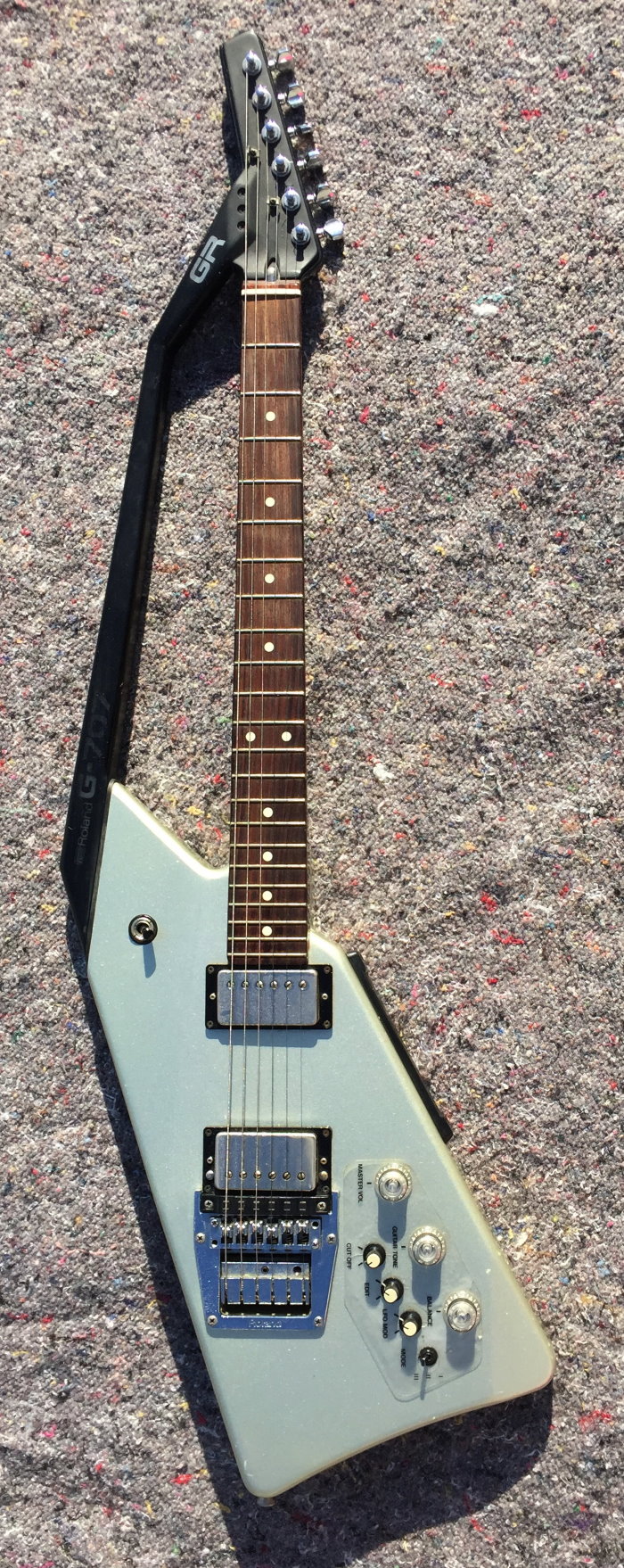


















ROLAND GUITAR G707 + SYNT GR700 + Connecting cable 220Volts All Original Comes in OHC code Va881
All working well without problem, guitar is in real super conditions no wear, perfect straight neck with good frets, no intonations problem with the synt, no buzz, tremolo is perfect.
6 voice, Dual Oscillator Synth Engine Based on the Roland JX-3P/MKS-30
3 - Selectable Octave Settings for Each Oscillator, 2’, 4’ and 8’
Choice of Square, Sawtooth or Pulse Waveform, plus Noise for Oscillator 2
Cross Modulation Between Oscillators
Frequency Modulation with Envelope and/or Modulation
VCF Low-Pass Filter with LFO, Envelope and Pitch Modulation
Variable High-Pass Filter
Four Stage Envelope Generator
Low Frequency Oscillator for Vibrato Effects
Selectable Dynamic Control Over Pitch, Filter and Amplifier per string
Selectable Pitch Bend, Hold and Voice On/Off per String
Lush Analog Chorus Mode
Programming Via Foot switches or with optional PG-200 Programmer
Dimensions: 27 3/16" (W) 14 3/4" (D) 6 1/8" (H)
Power Requirements: 45 watts
Response Time: 29.88 ms
The GR-700 is classic Roland 1980s analog
synthesizer technology. Released in late 1984, the GR-700 is the pinnacle of
early Roland guitar synthesizer design. The distinctive and futuristic
GR-700 features both a digital CPU for guitar tracking and a warm, fat
hybrid digital/analog synthesizer engine for lush sounds.
A look at articles written about the GR-700 in Guitar Player, Guitarist, and
other magazines, plus the synthesizer's appearance on television shows like
The Tonight Show (US) and the Rock School series (UK), demonstrate the
enthusiasm in the belief that the long anticipated age of the guitar
synthesizer had finally arrived. The GR-700 launched just as the MIDI
standard was being introduced, and musicians were entering a brave new world
of electronic music where relatively inexpensive CPUs made possible
instruments like the Prophet 5, Simmons drums, and the GR-700, instruments
unimaginable a decade earlier.
Generally speaking, the GR-700 has not held up as well as its 24-pin
brethren, like the GR-100 or GR-300. But for a guitar player in 1985, the
GR-700 offered an astonishing range of sounds that could never have been
triggered from a guitar: strings, basses, electronic effects, synths, and
more. It was assumed that guitar players eventually would become fluent in
GR-700 programming, and that the great silver box could become as ubiquitous
as the wah-wah pedal.
Like the current generation of Roland guitar synths, the GR-700 controls the
internal synth engine directly for faster response. But, make no mistake
about it, when it comes to tracking the GR-700 is not a GR-300. Of all the
products Roland has ever made, the GR-700 has the trickiest and most erratic
tracking. The GR-700 is certainly better than equivalent products made by
other manufactures at the time, but it is inferior to the GR-100, GR-300,
GM-70, Korg Z3, or the Ibanez MC-1. The GR-700 has a MIDI out port for
controlling other MIDI modules, but the MIDI output is erratic and
unreliable. In addition, no pitch bend information is sent via MIDI.
Stand alone converters like the GM-70 became more popular toward the end of
the eighties. They were faster and more accurate than the GR-700, plus via
MIDI the range of sounds available to guitar players expanded considerably.
The GR-700's combination of clunky pitch tracking, married to a limited
synth engine, boxed up inside a huge, heavy foot pedal crammed with complex
electronics made it more of a curiosity than a must-have piece of gear for
the gigging musician. Still, for those who love the GR-700, nothing else
sounds or responds quite like this unique guitar synthesizer.
The GR-700 was played and recorded by such prominent guitarists as Al
Dimeola, Robert Fripp, Chuck Loeb (video), Jimmy Page and Andy Summers. The
GR-700 was the top-of-the-line guitar synthesizer system in the mid-eighties.
Retail price on a GR-700 was almost two-thousand dollars. More recently,
Amir Derakh has used the Roland GR-700 extensively on several records.

The GR-700 has six, independent, analog synth voices, two
oscillators on each voice. Roland digitally clocked these oscillators and called
them "DCOs", as a response to the fact that the earlier Roland oscillator’s
pitch had a tendency to drift in performance. The DCOs on the GR-700 generate
classic analog waveforms: sawtooth wave, square wave, and pulse width modulated
wave, as well a noise for special effects.Roland PG-200 Programmer Map
The oscillators on the GR-700 can also be synced with cross modulation for hard,
biting analog sounds or with ring modulation for metallic sounds. The GR-700 has
a sweet Low Pass Filter with Resonance on each voice, with an additional High
Pass Filter. And of course there are complete LFO and Envelope controls. To top
it all off, the GR-700 adds a classic Roland analog Chorus circuit! If you like
that expansive Roland Chorus found on early 80s products, you will love the
Chorus on the GR-700.
The synth engine in the GR-700 is the same synth engine found in the Roland
MKS-30 and Jupiter JX-3P. And, like these synths, the Roland GR-700 can use the
PG-200 as a programming tool.
http://www.vintagesynth.org/roland/gr700.shtml
https://www.youtube.com/watch?v=uoFrNQh20GU
https://www.youtube.com/watch?v=6NvwdlblR-M

Steve Howe



John Abercrombie (see YouTube for video)


Jim Stafford Plays Synthesizer Guitar Branson, MO
